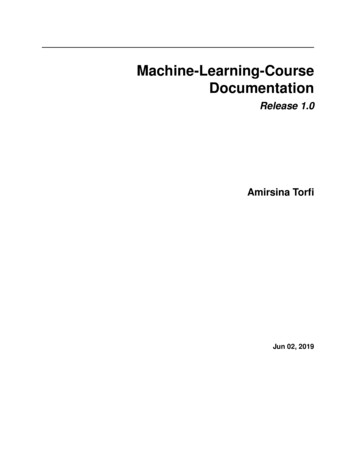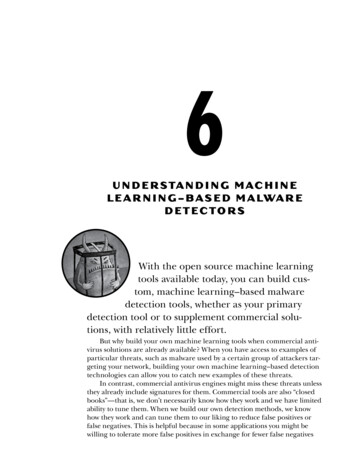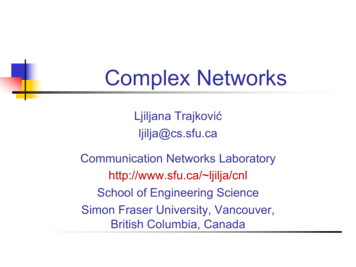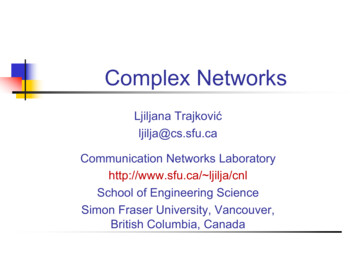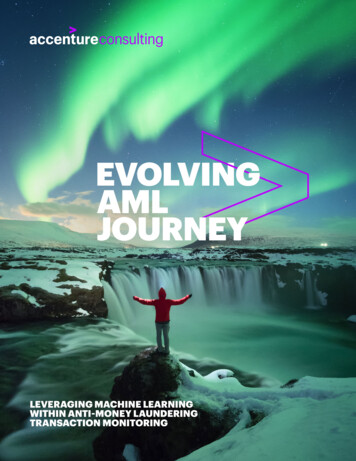
Transcription
LEVERAGING MACHINE LEARNINGWITHIN ANTI-MONEY LAUNDERINGTRANSACTION MONITORING
Artificial Intelligence (AI) and oneof its key components, MachineLearning (ML) are innovative anddisruptive technologies that arewidely used within many industrialsectors, including life sciences,automotive, aerospace and defense.However, despite numerous potentialapplications within the financial servicessector, specifically within Anti-MoneyLaundering (AML), adoption of AI and MLhas been relatively slow. This has been,in part, due to the following: (1) limitedcomprehension of the application of AIand ML within AML compliance programs;(2) the notion of ML being a “black box”where the inner workings are not clearlyunderstood by regulators and complianceofficers; and (3) the cautious approachtaken by regulators requiring complianceofficers to understand and validate howoutcomes from AML models are arrived at.2 EVOLVING AML JOURNEYNevertheless, when coupled with hybridmodels involving human resources supportedby AI, AML solutions can be developedthat provide significant benefits, includinga reduction in compliance costs andimprovements in the transaction monitoringprocess leading to greater overall efficiency.
ML APPLICATIONS FOR AMLTRANSACTION MONITORINGAI is a field of computer science focused on the developmentof computers to carry out activities typically executed byhumans, specifically activities requiring humans to takedecisions and rely on their intelligence.There are several component technologieswithin AI all with numerous applications.For example, Natural Language Processing(NLP), through which computers processhuman language, is used for translatingpayments in payment screening, processingmortgage applications and negative newsscreening (see Figure 1).ML is a sub-field of AI where computersare able to learn when exposed to newdata without being explicitly programed.The potential applications for this withinsuspicious activity monitoring andTransaction Monitoring (TM) are vast.A common TM challenge is the generationof a vast number of alerts requiring costlyoperations teams to triage the alerts.With increasing customer numbers, andincreasing numbers of transactions, TMalert volumes have increased significantlyat financial institutions (FIs). This increasein alerts has resulted in an upsurge in thenumber of personnel required to triage andprocess them. However, in leveraging ML atthe alert triage stage, alerts can potentiallybe suppressed, hibernated (set aside forlater examination) or even, at some timein the future, closed automatically.ML can teach computers to detect andrecognize suspicious behavior and classifyalerts following a risk-based approachas being of high, medium or lower risk.Applying rules to these alert classificationscan facilitate hibernation and auto closureof alerts, allowing human resources tosupervise machines that triage these alertsrather than reviewing alerts manually.This change is illustrated in Figure 2.Machines can be taught to recognize,score, triage, enrich, close or hibernatealerts. This can help focus experiencedhuman resources on complex problemswhile computers perform simpler tasksfor them. By using AI across the entire TMprocess, alerts can be auto-triaged leveragingML; they can be auto-enriched with account,transaction, and customer information fromexternal and internal data sources leveragingintelligent automation and NLP; and narrativesfor Suspicious Activity Reports (SARs) canbe auto-generated using Natural LanguageGeneration (NLG). Institutions leveraging AI inthis way can reduce dependencies on humanoperators to perform routine tasks, reducethe total time it takes to triage alerts, andallow personnel to focus on more valuableand complex activities.EVOLVING AML JOURNEY 3
Figure 1. Illustration of some AI Applications and ComponentsOther components include, Genetic Algorithms and Swarm Intelligence. This document largelyfocuses on ML for AML CEBASEDDocumentsRECOMMENDATIONENGINESPossible aturesAssessmentAdviceNLP/TEXT MININGDocumentNLGDataDataLanguageSource: The Artificial Intelligence Ecosystem, Narrative ScienceFigure 2. Introducing ML into AML TM Alert TriageWith the introduction of ML into AML TM alert triage, SAR conversion rates should improve from thecurrent unacceptable rate of 1% in the banking sector.ROTATING TO THE NEWDETECTRECOGNIZEPROCESSEscalated AlertsTXNSData riched AlertsAuto-triagedAlertsAutomationTM AnalystsAuto-closed / Hibernated AlertsHigh Potential to Reduce Human EffortSource: Accenture, September 20174 EVOLVING AML JOURNEYSARS1%AutomationClosed Alerts
CHALLENGES TOIMPLEMENTING MLThrough Accenture’s work with global FIs we have identifieda number of implementation challenges for financial servicesfirms seeking to implement ML as part of AML TM solutions.Figure 3. The Challenges to Implementing ML as part of a TM SolutionDQMand ProfileRefreshLack of a360-degreeView of theCustomerLack ofStraightforwardProcessesCHALLENGESFOR ML & AILimitedRegulatoryAppetiteLimitedKnowledge of bothFinancial Servicesand MLSource: Accenture, September 2017EVOLVING AML JOURNEY 5
These challenges include poor data quality,low Know Your Customer (KYC) profilerefresh rates, lack of a holistic view of thecustomer, limited knowledge of both financialservices and ML, regulatory expectationsand appetite, and lack of straightforwardprocesses to follow for implementation.1. Data quality management and profilerefresh. Data Quality Management (DQM)is a required activity for all monitoringsystems and analytics. It is not unique inany way to ML applications. Both staticfiles, for example KYC files, and dynamicdata held by FIs on their customers’transactions have seen low completenessratios in areas such as missing paymentinformation and high error rates in recentyears. Additionally, there is also a generallack of data traceability and data lineage.Some FIs address data issues on analert and/or profile basis when alertsare generated as false positives or noise.This method reduces reoccurrenceof noise or false positives. However,others prefer large-scale, one-offdata reconciliation/refresh exercises.During the last few years, many FIshave undertaken large and costly dataremediation projects to improve dataand have implemented frameworks tomanage data quality. However, dataquality remains an ongoing problem.To the challenge of missing and outdateddata, there is an opportunity to tie profilerefreshes into sales and marketingexercises. Relationship managerscan use profile refresh opportunitiesto reach out to their customers andidentify cross-selling opportunities.6 EVOLVING AML JOURNEY2. Lack of a 360-degree view of thecustomer. Another challenge inimplementing ML-supported TM programsis the inability for FIs to build a 360-degreeview of the customer. For example,financial services firms do not have theglobal freedom to share information abouttheir customers to build a comprehensivenetwork. Furthermore, FIs do not formallycollaborate on AML as this is a cost.Building a 360-degree view would requirecollaboration across FIs and informationagencies that does not exist today.Currently, once FIs decide to file an SARand submit it to the regulator, thereis limited feedback and intelligencereturned. In addition to sharinginformation securely between FIs andregulators, external (to KYC) data setscan be used in areas such as marketingdata, which has rich datasets on customerbehavior not generally used for AMLbehavior modeling and alert enrichmentand/or triage. However, there have beensome developments in recent yearsthat are paving the way to alleviate thischallenge of data sharing. Regulators areincreasingly leaning toward data sharingbetween banks. Relevant regulationsencouraging data sharing are US PatriotAct 314 a and 314 b and PSD2. The UKTreasury is also encouraging sharingof data via an Open Banking API/OpenBanking Working Group. However, dataownership, medium (e.g. cloud) and theextent of this data sharing needs to bedefined. It is a matter of time before largeamounts of transactional data will becomeavailable on intrabank data clouds.
3. Limited knowledge of both financialservices and ML. Another reason whyML has not been as widely appliedwithin the financial services industry isthat very few people are experts in bothML techniques and financial services.As a result, there have been fewerapplications targeting financial servicesproblems from start-ups and establishedvendors, limiting acceptance of ML withinthe financial services sector (especiallyfor financial crime prevention).4. Limited regulatory appetite. FIs haveheld back from implementing ML solutionsbecause regulators expect models that canbe clearly understood. They typically insistthat all choices, limitations, and resultsbe documented before such models areimplemented. In the regulators’ view, themodels should be designed in a way thatallows for results to be reproduced giventhe same input data. This is not alwayspossible with ML algorithms.5. Lack of straightforward processes.ML is a relatively new technology andthere are few established, straightforwardprocesses to follow to implement it.Without knowing what to look for, teachingsystems to detect certain types of financialcrime can be tricky. For example, howdoes one teach a system to recognizeterrorist financing? There is a carouselprocess for fraud but nothing similar forterrorist financing (nothing, that is, otherthan name matching against terroristlists). While some of these problems arebetter suited to unsupervised learning,model validators should be sure aboutthe desired outcomes.Additionally, there is some evidence thatlarge vendors are, in effect, acting asleading regulators. This is because someregulators recommend specific solutionsfor TM that are ineffective and generallyneed to be replaced by intelligent andadaptive solutions. These large playersdominate the technology space and,consequently, there is only a narrow fieldof play for start-ups. Start-ups tend toneed support from consultancies andother third parties that help banks withtheir evaluations and implementations.EVOLVING AML JOURNEY 7
MODEL VALIDATION ANDBLACK BOX TECHNIQUESFOR ML AML MODELSAny statistical model chosen by an FI for TM needs to follow stepssimilar to those illustrated in Figure 4.These steps are recommended by the Officeof the Comptroller of the Currency (OCC)for model risk management.1 Extensivedocumentation is required for modelsselected and the regulators expect FIsto be able to re-create results and explainexactly how their models work.The introduction of ML opens up numerousnew techniques for TM, all constructed withmathematical equations. Some of thesealgorithms or techniques are simpler tounderstand than others. Simpler algorithmsinclude decision trees while more complexalgorithms may comprise neural networks.Currently, there is no straightforwardmethod to validate complex or black boxML model choices for internal auditing andfor external regulatory purposes. Black boxML techniques can be tested by adopting(and adapting) the Turing test, wherebyhuman analysts are trained with the samesamples as machines and an observerevaluates results to determine precisionand recall. At the same time the observerneeds to determine which results wereproduced by a human and which wereproduced by an ML system. This processcould be undertaken as an interbank activity,possibly with the involvement of regulators.Algorithms that are predictable, traceable,and simple to explain are “white box”techniques. On the other hand, morecomplex algorithms are known as “blackboxes,” as the mathematical calculationsunderlying these techniques are far toodense and complex to be able to recreateresults and provide rationale for the learnedparameters (such as weighting). Figure 5illustrates how model validation becomesmore complicated as techniques movefrom “white box” to “black box.”However, just as current TM systemsrequire their scenarios and segments tobe updated, ML-based TM systems willalso have to be updated periodically. Thiscan be more complicated than standardTM system maintenance and ongoing testingis required. Realistically, such testing andupdating should be consultancy or vendordriven as part of an ongoing maintenancecontract. The slightest change in thetype of data that once produced desiredresults can render the system unreliable.8 EVOLVING AML JOURNEY
MODEL RISK MANAGEMENTGUIDANCEFigure 4. Summary of Model Risk Management Guidance from the OCCSENIOR MANAGEMENT OVERSIGHTCONCEPTSOUNDNESSONGOINGMONITORING· All model choices· Mathematical calculations· Key assumptions· Data, selection of inputs· Limitations· Benchmarking (precision,recall, harmonic mean)· User feedback· Limitations assessment· Time periods for testingOUTCOMEANALYSIS· Sensitivity analysis· Back testing (actual vs. forecast)· Testing approaches· Test data and outcomesPRE-IMPLEMENTATION AND POST-IMPLEMENTATIONSource: Supervisory Guidance on Model Risk Management, Board of Governors of the Federal Reserve System,the Office of the Comptroller of the CurrencyFigure 5. Complexity Scale for Model Validation of ML AlgorithmsMODEL VALIDATION FOR REGULATORSSIMPLERMoney Laundering?VolumeHigh CRRCOMPLEXHiddenInputOutputHighClassification andRegression Tree (CART)WHITEHyperplaneSupport Vector Machines (SVM)BOXArtificial NeuralNetwork (ANN)BLACKSource: Accenture, September 2017EVOLVING AML JOURNEY 9
HOW ACCENTURE CAN HELPAccenture provides services to global FIs to implement bothML and robotic process automation (RPA) programs.We have extensive capabilities in this area,including analytics and digital centres ofexcellence and subject matter specialists to: Identify and analyze business opportunities Assess the impact of possible solutions(such as updating procedure manualsversus adopting ML) Deliver innovative bespoke and industryleading technology solutions, includingimplementation of TM systems, AMLmodel validation, and operating modeltransformation to improve the humanand virtual workforceWe have vendor alliances, both withFintech start-ups2 and with leading firms.Accenture consultants meet on a regularbasis with new vendors, help vendors buildtheir capabilities in the financial crimeprevention space, and evaluate themto deliver greater value to clients. Withinthe financial crime space, Accenturehas established an effective and efficientmethodology to allow our clients to meetregulatory expectations and reducevolumes of TM and Name Screeningalerts. This methodology is illustratedin Figure 6 below.Figure 6. Summarized Steps for Rapid Benefits Realization from ML and RPAIDENTIFY DATASOURCES ANDSYSTEMSSCOPEIMPLEMENTATIONTRANCHES Identify painpoints Analyse availableand required data Identify processesand proceduresthat can beautomated Perform dataquality analysis(e.g. completenessratios) Outline immediate,mid-term andlong-term goalsDEFINEOPPORTUNITIES Build aconsolidated datarepository Define underlyingdata managementframeworkSource: Accenture, September 201710 EVOLVING AML JOURNEY Identify the "art ofthe possible" forautomation and ML Develop deliveryapproach androad mapBUILD AND TESTADVANCEDANALYTICSAPPLICATIONS Enhance andfix data Algorithm andvendor selection Build, deployand test proofsof concept Model validation andregulatory proving Implement and rollout model Monitor businessbenefitsROLL OUT,MAINTAIN ANDUPDATE Periodically reviewand tuneapplications forongoing suitablility User training andfeedback toimprove usability
Within the financial crime space, Accenturehas established an effective and efficientmethodology to allow our clients to meetregulatory expectations and reducevolumes of TM and name screening alerts.EVOLVING AML JOURNEY 11
CONCLUSIONMany banks have started implementing business processautomation in the form of RPA and see AI and particularlyML as the next step in the journey to greater efficiency andeffectiveness. Some banks, however, believe they should walkbefore they run, meaning that robotics solutions should bein place before AI ML solutions are considered.In fact, robotics and AI ML can existindependently of each other and eachcan support the other’s capabilities.Robotics can be used to train AI MLmodels and AI ML models can be usedto add decision-making (in the form ofNLP) or reading (via optical characterrecognition) capabilities to robotics models.12 EVOLVING AML JOURNEYThe appetite for automation isincreasing rapidly, but challengesremain. Implementing ML may improveevent‑to‑SAR conversion rates butthere will always be a need for humaninvolvement. Hybrid human/AI modelsare likely to appear in the near future andshould represent the next generationof AML TM alert operations teams. Theadoption of ML and, ultimately, AI in AMLis only the beginning of financial servicescompliance and resilience automation.
ABOUT THE AUTHORSSamantha ReganSamantha is a Managing Director, and isthe North America Lead for the RegulatoryRemediation & Compliance Transformationgroup within Accenture’s Finance & Riskpractice. Based in New York, she has17 years of global experience workingwith C-suite executives and their businessesin compliance and regulatory initiatives.Heather AdamsHeather is a Managing Director, AccentureFinance & Risk. Based in London, she leadsAccenture’s UK & Ireland Resilience team,developing capabilities and supportingclients in their efforts to be resilient toa range of external and internal threats,including financial crime. Heather hasextensive experience in delivering largescale complex business change for banksand has worked with senior leaders todefine and implement financial crime riskstrategies to drive high performance.Philippe GuiralPhilippe is a Senior Manager, AccentureFinance & Risk, based in New York. He leadsAccenture’s North America Financial CrimeGroup, and has over 12 years of experience,defining capabilities and strategies tosupport clients in their financial crimeprevention programs in both the UK andthe US. Philippe specializes in deliveringlarge-scale complex business andtechnology financial crime changeprograms to drive high performance.Saad ChoudriSaad Choudri is a Technology ConsultingPrincipal, Accenture Finance & Risk,based in London. Saad has over 12 yearsof international multisector experienceas a change professional with a specialfocus on financial crime prevention andartificial intelligence.EVOLVING AML JOURNEY 13
14 EVOLVING AML JOURNEY
The appetite for automation isincreasing rapidly, but challenges remain.Implementing ML may improve event-to-SARconversion rates but there will alwaysbe a need for human involvement.EVOLVING AML JOURNEY 15
REFERENCESABOUT ACCENTURE1. “Supervisory Guidance on Model RiskManagement,” Board of Governors ofthe Federal Reserve System, the Office of theComptroller of the Currency, April 4, 2011.Access at: 2011/bulletin-2011-12a.pdfAccenture is a leading global professionalservices company, providing a broad range ofservices and solutions in strategy, consulting,digital, technology and operations. Combiningunmatched experience and specialized skillsacross more than 40 industries and all businessfunctions—underpinned by the world’s largestdelivery network—Accenture works at theintersection of business and technology tohelp clients improve their performance andcreate sustainable value for their stakeholders.With more than 411,000 people serving clientsin more than 120 countries, Accenture drivesinnovation to improve the way the world worksand lives. Its home page is www.accenture.com2. FinTech Innovation Lab, /ACKNOWLEDGMENTSThe authors would like to thank the followingAccenture employees for their contributionto this document:Garikai MparutsaZhana GaliSTAY CONNECTEDAccenture Finance and Riskwww.accenture.com/financeandriskFinance and Risk Blogfinanceandriskblog.accenture.com/Connect With Uswww.linkedin.com/showcase/16183502/Follow Us CLAIMERThis document is intended for generalinformational purposes only and does nottake into account the reader’s specificcircumstances, and may not reflect the mostcurrent developments. Accenture disclaims,to the fullest extent permitted by applicablelaw, any and all liability for the accuracyand completeness of the information in thisdocument and for any acts or omissionsmade based on such information. Accenturedoes not provide legal, regulatory, audit,or tax advice. Readers are responsible forobtaining such advice from their own legalcounsel or other licensed professionals.Copyright 2017 AccentureAll rights reserved.Accenture, its logo, andHigh Performance Deliveredare trademarks of Accenture.173270
LEVERAGING MACHINE LEARNING WITHIN ANTI-MONEY LAUNDERING TRANSACTION MONITORING. 2 EVOLVING AML JOURNEY However, despite numerous potential applications within the financial services sector, specifically within Anti-Money Laundering (AML), adoption of AI and ML has been relatively slow. This has been,






